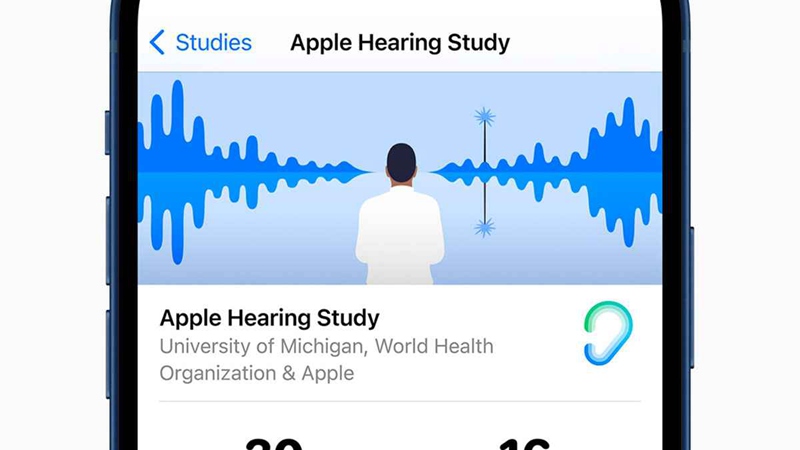
Hearing health is something many of us tend to ignore; in fact, we may not recognize the symptoms of hearing loss until communication becomes a significant challenge. Consider the fact that, according to Johns Hopkins Medicine, nearly 27 million Americans aged 50 and older have hearing loss, with only one in seven using a hearing aid.
Untreated hearing loss poses a serious threat to one’s overall quality of life, inhibiting learning and creating barriers that can lead to relationship challenges and isolation. Other effects include depression, poor balance, difficulty concentrating, and a greater risk of developing dementia.
Understanding the impact of noise exposure
Noise exposure is a constant threat to the hearing health of America. According to the Centers for Disease Control, 26 million Americans (aged 20-69) have “suffered permanent damage to their hearing from excessive exposure to noise.”
Recently, Apple set out to gain a better understanding of noise exposure and its overall impact on hearing loss and hearing health. In September 2019, the company launched its public hearing study, a collaboration with the University of Michigan School of Public Health, with the goal of guiding “public health policy and prevention programs designed to protect and promote hearing health in the U.S. and globally.”
Using the Apple Research app, study participants are asked to track their noise exposure and perform a variety of listening exercises using their Apple Watch or iPhone. Participants are also asked about tinnitus, hearing aid use, and their working environment.
 Through iOS 14 and watchOS 7, users can now understand how loudly they are listening to media through their headphones using their iPhone, iPod, or Apple Watch, and when these levels may impact hearing over time.
Through iOS 14 and watchOS 7, users can now understand how loudly they are listening to media through their headphones using their iPhone, iPod, or Apple Watch, and when these levels may impact hearing over time.Insights from the Apple Hearing Study
Apple collected information from the research app and, a year into the study, released a report on March 2, 2021, publishing key findings.
“Even during this pandemic, when many people are staying home, we’re still seeing 25 percent of our participants experiencing high environmental sound exposures,” said Rick Neitzel, associate professor of environmental health sciences at the University of Michigan School of Public Health. “The results of this study can improve our understanding of potentially harmful exposures and help identify ways that people can proactively protect their hearing.”
Further insights realized from the Apple Hearing Study included:
- Approximately 10 percent of participants have been professionally diagnosed with hearing loss. Of these, 75 percent do not use a hearing aid or cochlear implant.
- 20 percent of participants experience hearing loss as determined by WHO standards; 10 percent have hearing loss that is consistent with noise exposure.
- Nearly 50 percent of participants haven’t had their hearing tested by a professional in at least 10 years.
- Almost 50 percent of participants work or have worked in loud environments.
- 10 percent of participants are exposed to higher than recommended headphone volume levels.
- For 10 percent of participants, the average weekly headphone exposure is higher than the WHO recommended limit, which is judged on the basis of intensity, duration and frequency.
- 25 percent of participants experience ringing in their ears (tinnitus) a few times a week or more, which is a possible sign of hearing damage.
The future of hearing healthcare and research
The application of technology like this has the potential to change both the research landscape and how we manage our hearing health. Indeed, through this study, Apple customers are already participating in innovative research using technology that’s part of their everyday lives. Hopefully, the learning will be used to raise awareness, better connect us with healthcare providers, and enhance our wellness.
There’s also a tremendous potential for this process to expand. As Apple put it, our “data and participation in similar studies could help advance researchers' understanding of areas in health that have not been well understood until now and could lead to the development of new products that will help millions lead longer and healthier lives… The future of health research is you!”
How you can use Apple products today to improve your hearing
If you are suffering from mild hearing loss, or just have difficulty hearing in loud background noise, you might be able to benefit from some of Apple’s recent hearing health innovations. As of iOS 14, AirPods Pro are capable of providing personalized amplification—similarly to hearing aids. And, Apple just announced that AirPods Pro owners will get access to beamforming directional microphones later this year with the launch of iOS 15.
For more information on personalized amplification with AirPods Pro, check out our guide to setting up your AirPods Pro as “hearing aids” (quotes because technically they are not FDA approved to function as hearing aids). For those with worse-than-mild hearing loss, be sure to check out our introductory guide to medical-grade hearing aids.
The above is the interpretation of Apple’s Hearing Study: How Your Headphones Can Track Your Hearing Health provided by Chinese hearing aid supplier Shenrui Medical. Link https://www.sengdong.com/Blog/Apple-Hearing-Study-How-Your-Headphones-Can-Track-Your-Hearing-Health.html of this article is welcome to share and forward. For more hearing aid related information, please visit Blog or take a look at our Hearing aids products







